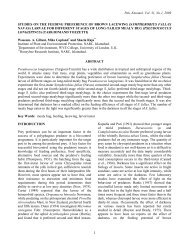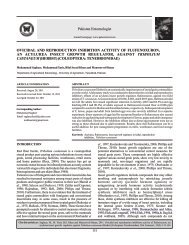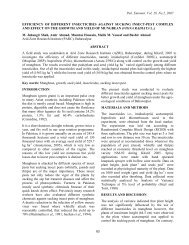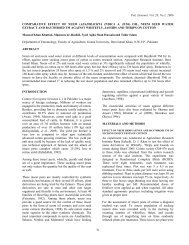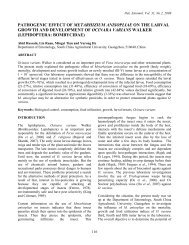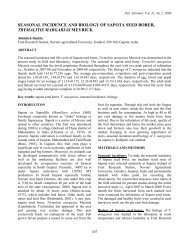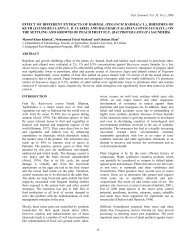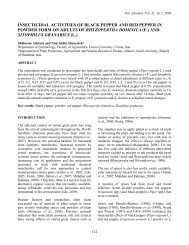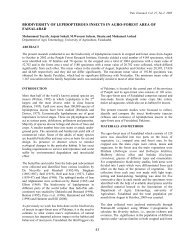Entomol. Journal Page Setting, all articles - Pakistan Entomologist
Entomol. Journal Page Setting, all articles - Pakistan Entomologist
Entomol. Journal Page Setting, all articles - Pakistan Entomologist
Create successful ePaper yourself
Turn your PDF publications into a flip-book with our unique Google optimized e-Paper software.
The host mortality caused by the heat and protease treated<br />
venom was almost similar to that mortality observed in<br />
control, which suggest that heat and protease treatments of<br />
venom have inactivated the proteins found in the venom<br />
blend of the wasp, confirming that the active components of<br />
the venom are proteins which are thermolabile and protease<br />
sensitive.<br />
Table 3<br />
Crude venom vs saline injections<br />
Total No.<br />
of injected<br />
host larvae<br />
Manzoor et al. / <strong>Pakistan</strong> <strong>Entomol</strong>ogist 2011, 33(2): 125-130<br />
Dead Alive % age of<br />
Mortality<br />
Mortality (%)<br />
Venom injected larvae 50 35<br />
15<br />
70<br />
Saline injected larvae 50 1 49 2<br />
(χ 2 = 50.173, P ≥ 0.05) df=1<br />
Table 4<br />
Venom treated with Heat vs saline injections<br />
Total No.<br />
of injected<br />
host larvae<br />
Dead Alive % age of<br />
Mortality<br />
Fig. 2<br />
Mortality of the host with heat treated venom and saline<br />
injected larvae of G. mellonella<br />
Venom treated with Heat 50 3 47 6<br />
Saline injected larvae 50 1 49 2<br />
χ 2<br />
=1.041 (χ 2<br />
=1.041, P ≤ 0.05) df=1<br />
Table 5<br />
Venom treated with proteases vs Saline injections<br />
Total No.<br />
of injected<br />
host larvae<br />
Venom treated with Heat 50<br />
Dead<br />
2<br />
Alive<br />
48<br />
% age of<br />
Mortality<br />
4<br />
Mortality (%)<br />
Saline injected larvae<br />
50<br />
χ 2 = 0.343 (χ 2 =0.034, P ≤ 0.05)df=1<br />
1<br />
49<br />
2<br />
Mortality (%)<br />
Fig. 1<br />
Mortality of the host with crude venom and saline injected<br />
larvae of G. mellonella<br />
Cite this article as:<br />
Fig. 3<br />
Mortality of the host with protease treated venom and saline<br />
injected larvae of G. mellonella<br />
DISCUSSION<br />
This preliminary study of functional analysis of the maternal<br />
secretions (venom) injected by ectoparasitoid B. hebetor in its<br />
host G. mellonella at the time of oviposition has <strong>all</strong>owed us to<br />
understand the mechanism of parasitization in host regulation<br />
process along with the chemical nature of the female secretion<br />
like venom to be involved in successful parasitization of the<br />
host. The venom of B. hebetor, is produced by the venom<br />
glands attached to the reproductive system of the female of the<br />
parasitoid which is responsible for immediate paralysis and<br />
death of the host, or at least stop the development of the host.<br />
Venom is a complex mixture of protinaceous compounds<br />
which usu<strong>all</strong>y cause particularly in Microbracon species<br />
Manzoor, A., Zain-ul-Abdin, M. Arshad, M.D. Gogi, H. Shaina, E. Mubarik, S.K. Abbas and M.A. Khan, 2011. Biological activity<br />
of the toxic peptides from venom of Bracon hebetor (Say.) (Hymenoptera: Braconidae). Pak. <strong>Entomol</strong>., 33(2): 125-130.<br />
128



